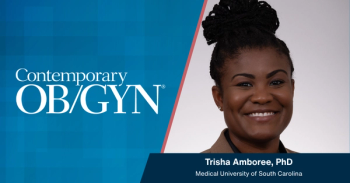
Emergency contraception update
In the nearly 40 years since the Yuzpe method was first described, options for emergency contraception-including over-the-counter availability-have expanded. Yet misunderstandings about these methods still exist.
Nearly 50% of pregnancies in the United States are unintended, affecting 3.2 million women in 2006.1 Of these, 52% of women report no contraception use and 43% report inconsistent use.2 Emergency contraception (EC) allows a woman the chance to decrease her risk of pregnancy after unprotected or underprotected intercourse.
EC is a postcoital method of pregnancy prevention. Although sperm can live in the reproductive tract for up to 5 days, an oocyte can be fertilized for a period of approximately 24 hours only. Therefore, the window during which unprotected sexual activity may lead to pregnancy is 5 days before to 1 day after ovulation.3 Studies have also shown that the frequency of sexual intercourse is highest during these 6 fertile days.4 Because women often inaccurately date their own menstrual cycles,5 however, EC may be utilized at any point during the menstrual cycle.
Access to EC in the United States has changed significantly over the past 50 years. Research on postcoital use of contraceptive steroids began in the 1960s and was first published in 1974,6 but no medications were officially marketed for EC until 1998. Since then, 4 formulations have been approved for EC: Preven (Gynétics) and Plan B (Teva), approved in 1999; Next Choice (Watson) and Plan B One-Step (Teva), approved in 2009; and ella (Watson), approved in 2010. These products and “off-label” methods will be discussed here (Table).7
Combined hormonal regimens (Yuzpe method)
Combined EC pills contain the hormones ethinyl estradiol and progestin (usually levonorgestrel [LNG] or norgestrel), taken in 2 doses. Often called the Yuzpe method, after the physician who first described it in 1974,6 this method is shown to delay or suppress the luteinizing hormone (LH) surge, thereby delaying or inhibiting ovulation.6,8 A meta-analysis of 8 studies of women using the Yuzpe method within 72 hours of unprotected intercourse showed the regimen was effective at decreasing the observed number of pregnancies by 74%.9-11 There is evidence that the Yuzpe method is effective up to 120 hours after unprotected intercourse, but the efficacy decreases as the time interval increases.12
The most common side effects of the Yuzpe method are nausea (54%), vomiting (16.3%), and headache (13.1%).13 Giving an antiemetic 1 hour before the estrogen-progestin regimen significantly decreases incidence and severity of nausea and vomiting.14
Oral contraceptive pills (OCPs), which are used in the Yuzpe regimen, are not labeled for EC. However, in 1997, the US Food and Drug Administration (FDA) declared emergency contraceptive use of OCPs to be safe and effective.15 The dedicated EC product Preven (Gynétics) was approved by the FDA in 1998 but taken off the market in 2004 with the advent of progestin-only EC. Currently 19 different brands of OCPs can be used for the Yuzpe method, with differing numbers of pills comprising the appropriate dose of each hormone. A table that lists the available brands and contains other comprehensive information about EC is maintained by the Office of Population Research at Princeton University and is accessible at
Progestin-only regimens
LNG has been shown to prevent ovulation when given in the follicular phase if administered at least 2 days prior to the LH surge.16-18 Two dosing options exist for EC with LNG-1 1.5-mg pill or 2 0.75-mg pills given 12 hours apart-and 3 studies have compared the 2 regimens. Arowojolu et al found increased efficacy for the single- versus 2-dose regimen (93% vs 86.8%). Profiles were similar for nausea, vomiting, and other adverse effects, with an increased risk of headache (21.3% vs 14.5%) and breast tenderness (12.9% vs 8.8%) with the single-dose regimen.19 Dada et al found no difference in efficacy (94.7% vs 95.2%) or adverse effects.20 A third study similarly found no difference in pregnancy rates (1.5% for a single dose vs 1.8% for 2 doses) and no difference in adverse effects.21 Because the 12-hour dosing interval can be inconvenient and does not have increased efficacy, it is not recommended.
When compared with the Yuzpe method, a Cochrane review found a risk ratio for pregnancy of 0.54 (95% confidence interval [CI], 0.36-0.80) for LNG. The review also reports a 0.80 (95% CI, 0.75-0.86) risk ratio for any adverse effect, with decreased risks of nausea, vomiting, headache, and fatigue.22
LNG is approved for use in the United States as EC under the name Plan B One-Step (Teva) or Next Choice (Watson). Plan B One-Step is 1 1.5-mg pill, while Next Choice is 2 0.75-mg pills.23 A split-dose formulation of Plan B was available but has been discontinued. All 3 LNG methods are approved for use within 72 hours of unprotected intercourse, although data support some continued efficacy with postcoital use of up to 120 hours.21
Antiprogestins
Mifepristone is a first-generation progesterone receptor modulator that is used in the United States and other countries for early first-trimester medical abortion. It has been shown to be highly effective for EC with few adverse effects when used at a much lower dose than that for abortion induction.22 Lower-dose mifepristone, however, is not available in the United States, and given the significant political issues surrounding the drug’s use as an abortifacient, it is unlikely to be approved for EC in this country.
Ulipristal acetate (UPA) is a second-generation selective progesterone receptor modulator that is given as a single dose of 30 mg up to 120 hours after unprotected intercourse. It suppresses follicular growth when given during the midfollicular phase. When given on the day of LH peak, UPA can delay follicular rupture for 24 to 48 hours.24 The drug thus can affect ovulation after LH has begun to rise, when the Yuzpe method and LNG are ineffective.
Two noninferiority trials have compared UPA with LNG. Creinin et al compared UPA with the 2-dose regimen of LNG within 72 hours of unprotected intercourse and found comparable efficacy (85% [95% CI, 68%-93%] for UPA; 69% [95% CI, 46%-82%] for LNG).25 Nausea was more common in the UPA group (29% vs 24%, respectively) while other adverse effects were similar. Glasier et al gave 30 mg UPA or 1.5 mg LNG within 120 hours of unprotected intercourse. 26 No difference in pregnancy rates was seen (1.8% for UPA and 2.6% for LNG) and adverse effects were similar for both groups.
A meta-analysis of the data from the 2 previous studies showed that UPA is statistically significantly superior to LNG for use within 24 hours (OR, 0.35; 95% CI, 0.11-0.93) and within 120 hours (OR, 0.55; 95% CI, 0.32-0.93), indicating improved efficacy for both early and late administration.26
Copper IUD
The copper intrauterine device (IUD) was reported as an option for postcoital contraception in 1976.27 In a randomized controlled trial published in 1987, Askalani et al found a pregnancy rate of 2% in women who used copper IUDs within 4 days of unprotected intercourse, compared with 22% in the control group.28 Incorporating nonrandomized studies, the Cochrane review on EC reports a failure rate of 0.09% for the copper IUD.22
Because implantation occurs 6 to 12 days after fertilization, the copper IUD can be placed up to 5 days after ovulation to prevent pregnancy. In reality, most women do not know when they ovulate. Therefore, many protocols allow insertion of the copper IUD up to 5 days after unprotected intercourse. The copper IUD’s high efficacy for EC even when used up to 5 days after ovulation implies a post-fertilization effect of pregnancy inhibition.
One major advantage of the copper IUD is that it can be left in place for 10 years to provide ongoing contraception. A prospective cohort study of the copper IUD as EC found that 95.7% of parous patients and 80.0% of nulliparous patients wanted to keep the IUD in place after the study ended.29 Use of the LNG-releasing IUD for EC has not been studied and is not recommended.
Clinical considerations
Although EC was FDA-approved in 1998, access remained limited because of the need for a prescription and the delay associated with a visit to an appropriate provider. In 2007, the FDA approved over-the-counter (OTC) availability for EC (Plan B and Next Choice) for women aged 18 and older. In 2009, the FDA changed the age limit, enabling access for women aged 17 and older. Women younger than age 17 need a prescription for LNG EC. UPA is available only by prescription to all women. Because use of EC is time dependent, women should be routinely counseled about its availability before the need arises. Advanced provision of a prescription is important and recommended. Teenagers younger than age 17 are required to have a prescription for either type of EC pill, and a prescription can also reduce the cost to older women whose insurance provides coverage for EC.
Despite the fact that EC has been available OTC since 2007, a 2012 study demonstrated limitations in knowledge about it at the pharmacy level. Wilkinson et al reported that while 80% of pharmacies said they carried EC, only 57% knew the correct age at which EC could be dispensed without a prescription and 19% incorrectly told adolescents that it would be impossible to obtain EC under any circumstances. In contrast, only 3% of callers who identified themselves to pharmacies as physicians were told that it would be impossible to obtain EC, indicating a serious potential for misinformation and accessibility issues.30
Neither a physical examination nor laboratory tests are required before administering oral EC. There are no contraindications to LNG emergency contraception and no teratogenic risks to a pregnancy conceived while using oral contraceptive hormones.15 Women for whom use of combined hormonal contraception is contraindicated should not use the Yuzpe method. Because UPA and placement of a copper IUD could disrupt an established pregnancy, pregnancy should be ruled out on the basis of history and/or physical exam and pregnancy test, as indicated.
With the exception of the copper IUD, EC does not prevent pregnancy with future acts of unprotected intercourse during the same menstrual cycle. Therefore, women should be counseled about the lack of future efficacy of a single dose of EC and offered a long-term method of contraception as indicated. Scheduled follow-up is not required after using EC. However, a woman should be instructed to receive an evaluation for pregnancy if her menstrual period is delayed by more than a week. She should also be counseled that EC does not protect against sexually transmitted infections. We have prepared an EC handout (Figure) as a starting point for answering patients’ questions.
Summary
EC offers women a last chance at preventing an unplanned pregnancy after unprotected intercourse. UPA is the most effective available form of oral EC, especially 72 hours after unprotected intercourse, and is available by prescription only. LNG is also effective for postcoital prevention of pregnancy and is available OTC to women aged 17 and older; however, those younger than 17 years are required to have a prescription. The Yuzpe regimen may be less effective and associated with more adverse effects, but it may still be useful for women who do not have access to other EC or have privacy concerns about obtaining EC. The copper IUD is the most effective form of postcoital contraception and has the benefit of continued pregnancy protection for up to 10 years, but it requires a trained provider for insertion. For all methods, advanced education about the availability of EC and increasing access is imperative.
References
1. Finer LB, Zolna MR. Unintended pregnancy in the United States: incidence and disparities, 2006. Contraception. 2011;84(5):478-485.
2. Guttmacher Institute. Fact Sheet: Contraceptive Use in the United States. 2012. http://www.guttmacher.org/pubs/fb_contr_use.html.
3. Wilcox AJ, Weinberg CR, Baird DD. Timing of sexual intercourse in relation to ovulation. Effects on the probability of conception, survival of the pregnancy, and sex of the baby. N Engl J Med. 1995;333(23):1517-21.
4. Wilcox AJ, Baird DD, Dunson DB, McConnaughey DR,
Kesner JS, Weinberg CR. On the frequency of intercourse around ovulation: evidence for biological influences. Hum Reprod. 2004;19(7):1539-1543.
5. Stirling A, Glasier A. Estimating the efficacy of emergency contraception-how reliable are the data? Contraception. 2002;66(1):19-22.
6. Yuzpe AA, Thurlow HJ, Ramzy I, Leyshon JI. Post coital contraception-a pilot study. J Reprod Med. 1974;13(2):53-58.
7. Committee on Adolescence. Emergency contraception. Pediatrics. 2012;130(6):1174-1182.
8. Croxatto HB, Devoto L, Durand M, et al. Mechanism of action of hormonal preparations used for emergency contraception: a review of the literature. Contraception. 2001;63(3):111-121.
9. Creinin MD. A reassessment of efficacy of the Yuzpe regimen of emergency contraception. Hum Reprod. 1997;12(3):496-498.
10. Trussell J, Rodríguez G, Ellertson C. Updated estimates of the effectiveness of the Yuzpe regimen of emergency contraception. Contraception. 1999;59(3):147-151.
11. Ellertson C, Webb A, Blanchard K, et al. Modifying the Yuzpe regimen of emergency contraception: a multicenter randomized controlled trial. Obstet Gynecol. 2003;101(6):1160-1167.
12. Piaggio G, von Hertzen H, Grimes DA, Van Look PF. Timing of emergency contraception with levonorgestrel or the Yuzpe regimen. Task Force on Postovulatory Methods of Fertility Regulation. Lancet. 1999;353(9154):721.
13. Shochet T, Blanchard K, King H, et al. Side effects of the Yuzpe regimen of emergency contraception and two modifications. Contraception. 2004;69(4):301-307.
14. Raymond EG, Creinin MD, Barnhart KT, Lovvorn AE,
Rountree RW, Trussell J. Meclizine for prevention of nausea associated with use of emergency contraceptive pills: a randomized trial. Obstet Gynecol. 2000;95(2):271-277.
15. Department of Health and Human Services, US Food and Drug Administration. Prescription drug products; certain combined oral contraceptives for use as postcoital emergency contraception. Federal Register. 1997;62(37):8610-8612.
16. Croxatto HB, Brache V, Pavez M, et al. Pituitary-ovarian function following the standard levonorgestrel emergency contraceptive dose or a single 0.75-mg dose given on the days preceding ovulation. Contraception. 2004;70(6):442-450.
17. Durand M, del Carmen Cravioto M, Raymond EG, et al. On the mechanisms of action of short-term levonorgestrel administration in emergency contraception. Contraception. 2001;64(4):227-234.
18. Marions L, Cekan SZ, Bygdeman M, Gemzell-Danielsson K. Effect of emergency contraception with levonorgestrel or mifepristone on ovarian function. Contraception. 2004;69(5):373-377.
19. Arowojolu AO, Okewole IA, Adekunle AO. Comparative evaluation of the effectiveness and safety of two regimens of levonorgestrel for emergency contraception in Nigerians. Contraception. 2002;66(4):269-273. Erratum in: Contraception. 2003;67(2):165.
20. Dada OA, Godfrey EM, Piaggio G, von Hertzen H; Nigerian Network for Reproductive Health Research and Training. A randomized, double-blind, noninferiority study to compare two regimens of levonorgestrel for emergency contraception in Nigeria. Contraception. 2010;82(4):373-378.
21. von Hertzen H, Piaggio G, Ding J, et al; WHO Research Group on Post-ovulatory Methods of Fertility Regulation. Low dose mifepristone and two regimens of levonorgestrel for emergency contraception: a WHO multicentre randomised trial. Lancet. 2002;360(9348):1803-1810.
22. Cheng L, Che Y, Gülmezoglu AM. Interventions for emergency contraception. Cochrane Database Syst Rev. 2012;8:CD001324.
23. Murphy PA. Update on emergency contraception. J Midwifery Womens Health. 2012;57(6):593-602.
24. Brache V, Cochon L, Jesam C, et al. Immediate pre-ovulatory administration of 30 mg ulipristal acetate significantly delays follicular rupture. Hum Reprod. 2010;25(9):2256-2263.
25. Creinin MD, Schlaff W, Archer DF, et al. Progesterone receptor modulator for emergency contraception: a randomized controlled trial. Obstet Gynecol. 2006;108(5):1089-1097.
26. Glasier AF, Cameron ST, Fine PM, et al. Ulipristal acetate versus levonorgestrel for emergency contraception: a randomised non-inferiority trial and meta-analysis. Lancet. 2010;375(9714):555-562.
27. Lippes J, Malik T, Tatum HJ. The postcoital copper-T. Adv Plan Parent. 1976;11(1):24-29.
28. Askalani AH, Al-Senity AM, Al-Agizy HM, Salem HI, Al-Masry GI, El-Sadek SM. Evaluation of copper T-200 as a post-coital contraceptive.
J Egypt Soc Obstet Gynecol. 1987;13(2):63-66.
29. Zhou L, Xiao B. Emergency contraception with Multiload Cu-375 SL IUD: a multicenter clinical trial. Contraception. 2001;64(2):107-112.
30. Wilkinson TA, Fahey N, Shields C, Suther E, Cabral HJ, Silverstein M. Pharmacy communication to adolescents and their physicians regarding access to emergency contraception. Pediatrics. 2012;129(4):624-629.
Dr. Gold is an instructor and fellow in family planning in the Department of Obstetrics and Gynecology at Johns Hopkins Bayview Medical Center, Baltimore, Maryland.
Dr. Jamshidi is an assistant professor in the Department of Obstetrics and Gynecology at Johns Hopkins Bayview Medical Center, Baltimore, Maryland.
Newsletter
Get the latest clinical updates, case studies, and expert commentary in obstetric and gynecologic care. Sign up now to stay informed.




















